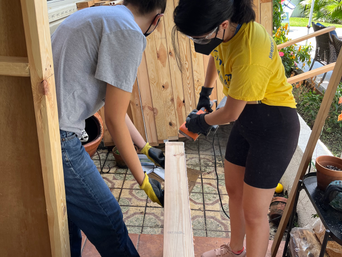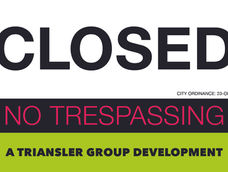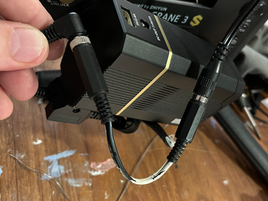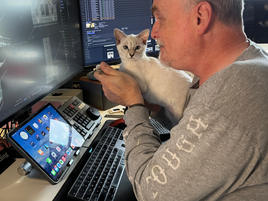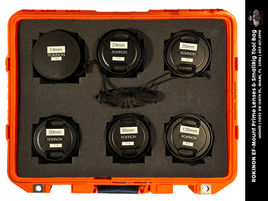
Behind the Scenes
How We Made Our Short Film
It's all fun and games until...well, actually, it is usually all fun and games when you have the right team and story to shoot. But it’s still real work making a film. Follow along as we showcase the various production challenges we faced and how we brought the locations to life through resourceful and innovative processes.

Stagecraft
Stagecraft is alive and well here at PICTURE END. We constructed twenty-five 4’ x 8’ flats with 2x4 frames and ⅛” utility plywood facing. We used 5 of them for the Tower Theatre’s entry (where we shot the exterior scenes) and 20 for the on-stage booth set. We shot all the interior booth scenes on The Little Haiti Cultural Center’s stage. It was a less expensive alternative to using a real soundstage. The construction team needed only a few support outriggers because the overall set built was self-standing. Strategically, we cut the various ports and windows, filling them with ⅛” plexiglass, then trimmed the frames on location. This ensured the set would come together quickly with minimal damage. We preprinted and decorated the panels using spray paint and our fake movie posters, band promos, and the gigantic advert for the “Palisades’” evil replacement. The Tower Theatre management team even allowed us to use their marquee poster frames for some of our fake movie posters. All together the PICTURE END construction team whipped our sets into shape efficiently and had fun while building the various pieces. Of course, strike was both satisfying and melancholy watching all our hard work torn down only after three days of use.


Props to Us
There are several props and set elements that stand out because of the design and detail we applied to each.
The booth floor: Instead of the usual painted concrete floor, or perhaps terrazzo if the theatre was old enough, I decided on an art deco checkerboard pattern using 1-foot square “tiles.” They were actually black & white sheets of heavy construction paper, glued onto 30’L by 3’W industrial rollable cardboard, then sealed with glossy ModPodge. Once at the stage, we unrolled the floor strips then stuck them together, completing the floor’s illusion. This classic pattern, typical of floors in the Caribbean, drove the viewer’s eyes into the booth’s restricted physical space.
The sound rack: Being the cinema nerd I am, I wanted to build a convincing and visually tactile prop. A real audio rack to build this out would have been prohibitively expensive, so I created mock-ups of each item—a Dolby CP-500, some audio amps, and a functional DVD player for Wade to interact with.
Special touches to the construction include: physically correct system rack construction, carefully illustrated then rendered photo-real prints of each tech component, then I added rear lit LCD screen, real knobs, and LEDs to add realism.
Was this level of realism necessary? I believe that anything that causes the audience to suspend belief, even for seemingly mundane props, creates a subconscious criticism, which may prevent them from taking in the screen’s message. Plus, it was super cool to make. 😎


Graphics and Production Art
To enhance the sets and locations, we created unique graphical images, items such as fake movie posters, old newspaper articles, advertisements, and band flyers, all by several talented artists. In addition to the original art, I used Midjourney AI to create a few graphical elements to decorate our scenes, resulting in fun little details which provided a genuine place to photograph.


Production Technology
It wasn't so long ago that shooting a film meant using actual "film," the chemical analog medium, which was pretty costly. Most independent and short films relied on the simpler Super-8, or 16mm technology because of the significant savings but at the cost of grainy images. Most of us couldn’t afford 35mm, yet alone 65mm (or IMAX 🤣). But with the genesis of the digital cinema cameras, incredible quality has become affordable. Not that the tech should define the film. Hell, some great movies have been shot on Super-8 and 16mm with very basic equipment. Nonetheless, iPhones, DSLRs and dedicated dCinema systems have caused a paradigm shift within the cinema industry. Digital cinema isn't necessarily better than film, nor is film better than dCinema. Both have their advantages and place within the creative production process. We used a Blackmagic Pocket Cinema Camera 6K with sensitive prime lenses and an ultra-wide angle zoom to capture our scenes. The camera was mounted either on a tripod, a shoulder mount, or a Zhiyun Crane 3S Camera Gimbal. We used a Sennheiser shotgun and Shure lavalier recording to a Tascam digital audio recorder and directly feeding the camera. We shot the aerials with a DJI Mini Pro 3 drone, then used Cinema 4D to create 3D camera tracking data.
Post-Production was done with DaVinci Resolve Studio for editing and grading. I created several 3D scenes (a new façade for the Tower Theatre in Miami, and virtual fire for the booth locations) with Maxon's Cinema 4D, rendered with Redshift, then composited in After Effects.


Behind The Scenes Pics
Here's a collage of photos taken during the pre-production and production stages of the film. Post-production is just basically me sitting behind the computers, pushing pixels. Whee.












